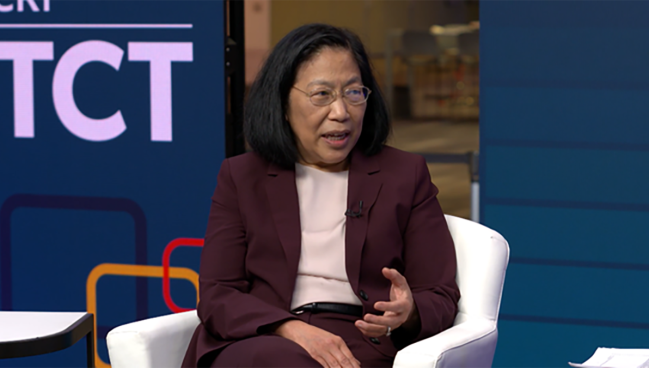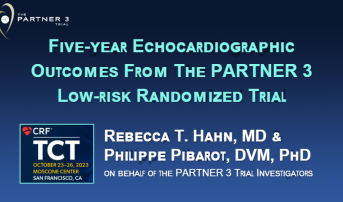Durability, Hemodynamics Look Good for SAVR, TAVI in PARTNER 3
Echo data show no signs of deterioration from thrombosis or structural issues, but experts say more follow-up is warranted.

SAN FRANCISCO, CA—An echocardiographic deep dive into low-risk patients treated in the PARTNER 3 trial provides some reassurances—at least at this 5-year time point—that bioprosthetic valve hemodynamics and durability do not differ between patients treated with TAVI and those who underwent surgery.
Presenting data last week at TCT 2023, Rebecca Hahn, MD (NewYork-Presbyterian/Columbia University Irving Medical Center, New York, NY), reported that there was a sustained improvement in mean aortic valve gradient and aortic valve area with both TAVI and surgery, while Philippe Pibarot, DVM, PhD (Laval University, Quebec City, Canada), showed that rates of bioprosthetic valve failure related to structural valve deterioration were not statistically different between TAVI and surgery (1.6% vs 2.4%, respectively; P = 0.42).
“The rates were very low,” said Pibarot. “I was struck by these results.”
In terms of what is probably the most important endpoint, said Pibarot, bioprosthetic valve failure from any cause, whether from structural valve deterioration, endocarditis, paravalvular regurgitation, thrombosis, or prosthesis-patient mismatch, was 3.8% with surgery and 3.3% with TAVI at 5 years, a nonsignificant difference.
Patrick O’Gara, MD (Brigham and Women’s Hospital, Boston, MA), one of the panelists during the echo deep dive, was pleased with the results, noting that it’s important to see “mechanistic data” underpinning the positive 5-year clinical outcomes. “It’s a little complicated for the consumer to understand all of the nuances by which structural valve deterioration, thrombosis, endocarditis, and bioprosthetic valve failure are defined,” he said. “But I think the take-home message from the 30,000-foot level is that it looks OK. So far, so good, but these are 5-year data.”
The [bioprosthetic valve failure] rates were very low. I was struck by these results. Philippe Pibarot
Cardiac surgeon Michael Mack, MD (Baylor Scott & White Health, Dallas, TX), one of the principal investigators of PARTNER 3, said that while it’s only 5-year follow-up, “there’s absolutely no signal of an issue in either arm.” He noted that the risk of valve thrombosis in PARTNER 3 was higher among patients treated with TAVI, which led to higher rates of moderate or severe bioprosthetic valve deterioration caused by thrombosis (3.4% with TAVI vs 0.4% with surgery).
“The most intriguing durability signal that I’ll be looking for is [in] these valve-thrombosis patients,” said Mack. “We now know valve thrombosis is not frequently associated with clinical events, but is it associated with shortened durability long term?”
Echocardiographic Deep Dive
Martin Leon, MD (NewYork-Presbyterian/Columbia University Irving Medical Center), presented the full PARTNER 3 data during a late-breaking clinical trial session last week, as reported by TCTMD. Those showed there was no significant difference in the risk of death, disabling stroke, or rehospitalizations between TAVI with the balloon-expandable bioprosthesis (Sapien 3; Edwards Lifesciences) and SAVR at 5 years.
The early benefit with TAVI, however, attenuated over time and mortality curves actually crossed in favor of surgery at 2-3 years, although the difference was not statistically significant at 5 years.
Later that same day, Hahn presented the echocardiographic data, which was available for 78.8% of patients in both study arms. At 5 years, the mean aortic valve gradient was slightly higher with TAVI than with surgery (12.8 vs 11.7 mm Hg; P < 0.001), but there was no significant difference in aortic valve area (1.87 vs 1.82 cm2, respectively; P = 0.90).
“Taken together, the higher gradient, but larger valve area, suggests that perhaps flow is playing a role in the gradients,” said Hahn. “In fact, what we showed was that the left ventricular stroke volume was indeed higher in the transcatheter aortic valve replacement patient.”
There was a sustained reduction in left ventricular mass over time in both treatment arms, reaching normal values at 1 year. The follow-up data suggested that LV mass continued to decline between 1 and 5 years, which Hahn cautiously said hints at further remodeling. Valvulo-arterial impedance (Zva), which is an estimate of global LV load, declined after TAVI and surgery but remained higher with SAVR at 5 years. This finding is explained by the higher stroke volume with TAVI, said Hahn.
On the right side, tricuspid annulus plane systolic excursion (TAPSE), which is a measure of right ventricular function, was lower with surgery after 5 years. Hahn noted that TAPSE declined in the first 30 days after surgery, and while it improved in follow-up, the difference compared with TAVI remained statistically significant at 5 years. Similarly, when RV function was indexed to pulmonary arterial systolic pressure—a measure of RV-PA coupling—outcomes were more favorable with TAVI.
We as surgeons have been burned by thinking 5 years is long enough. Gorav Ailawadi
Hahn said the difference in stroke volume between surgery and TAVI is likely explained by differences in RV function. But during the discussion, cardiac surgeon Gorav Ailawadi, MD (University of Michigan Medical School, Ann Arbor), pushed back on the concept that surgery worsens RV function.
“As a surgeon, it’s alarming to suggest that surgery causes the RV to deteriorate, something that’s never been shown before,” he said. “So, I’m very curious as to why you think this is, assuming the gradients are equivalent essentially.”
In response, Hahn stressed that the data aren’t showing that RV function deteriorates with SAVR. An echocardiographic reduction of RV function, assessed with TAPSE, after cardiac surgery has been shown before, however.
“This was initially thought to be almost an ‘artifact’ of the loss of pericardial constraint, and thus not representative of actual loss of RV function,” Hahn told TCTMD in an email. “Other studies suggest that there may be actual structural changes with real loss in function. Our study supports this because the loss of RV TAPSE (longitudinal function) mirrors a loss of LV stroke volume (so loss of forward flow). Some believe that the loss of function may be related to cardiopulmonary bypass and cardioplegia or air embolism—the loss of longitudinal function is not completely understood, but nonetheless, well-documented in other studies.”
The gradual improvement in stroke volume and TAPSE may be related to “compensatory changes in RV contractility and the recruitment of circumferential fibers,” she added.
In an analysis that combined both surgical and TAVI patients, neither prothesis-patient mismatch, paravalvular regurgitation, nor stroke volume at 30 days was associated with the study’s primary endpoint. On the other hand, a moderate increase in Zva (defined as ≥ 4 mm Hg/mL/m2), was associated with worse outcomes, mainly driven by more hospitalizations. Impaired RV-PA coupling was also associated with worse outcomes, but this was driven by more cardiovascular deaths and stroke.
Hahn said they plan to look at whether Zva and RV-PA coupling are predictive of outcomes at 5 years in the two treatment arms as opposed to the whole PARTNER 3 population.
Reversible With Anticoagulation
During his look at bioprosthetic valve dysfunction and failure, Pibarot said they relied on the 2021 VARC-3 definitions. Structural valve deterioration, he explained, is an intrinsic permanent change to valve, such as wear and tear, leaflet disruption, flail, fibrosis, and/or calcification, that is staged based on the extent of hemodynamic changes.
The incidence of moderate and severe bioprosthetic valve dysfunction from any cause was higher with TAVI than surgery at 5 years (9.1% vs 4.8%; P = 0.01). This difference, as noted, was mainly related to a higher incidence of dysfunction resulting from thrombosis in the TAVI-treated patients, said Pibarot.
“However, the vast majority of dysfunction was reversible with anticoagulation therapy,” he said.
On the other hand, said Pibarot, bioprosthetic valve dysfunction related to structural valve deterioration, which is the type of dysfunction that can impact valve durability, was low and similar between both treatment groups (4.2% with TAVI vs 3.8% with surgery; P = 0.81).
During the late-breaking science session, Ailawadi praised the PARTNER 3 investigators, as well as the Evolut Low Risk trial group, for their plans to continue echocardiographic and clinical follow-up out to 10 years. “We as surgeons have been burned by thinking 5 years is long enough,” he said.
Michael O’Riordan is the Managing Editor for TCTMD. He completed his undergraduate degrees at Queen’s University in Kingston, ON, and…
Read Full BioSources
Hahn RT, Pibarot P, on behalf of the PARTNER 3 investigators. Five-year echocardiographic outcomes from the PARTNER 3 low-risk randomized trial. Presented at TCT 2023. October 24, 2023. San Francisco, CA.
Pibarot P, Hahn RT. An echo deep dive of the PARTNER 3 low-risk randomized trial at 5 years. Presented at TCT 2023. October 24, 2023. San Francisco, CA.
Disclosures
- Hahn reports speaker fees from Abbott, Boston Scientific, Edwards Lifesciences, Medtronic, and Philips.
- Pibarot reports institutional research funding from Edwards Lifesciences, Medtronic, Novartis, Pi-Cardia, and Cardiac Success.








Comments